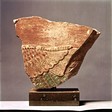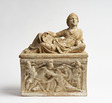Welcome to the Tracking Colour objects database. It contains information on ancient artworks from the collections of the Ny Carlsberg Glyptotek examined for their original polychromy.
All objects 173 objects
-
Fragment from the Palace of Apries

- ÆIN 1051
- Ny Carlsberg Glyptotek
-
Fragmented relief with three rows of stars on a blue background.
-
Fragment from the Palace of Apries

- ÆIN 1054
- Ny Carlsberg Glyptotek
-
Fragmented relief with three rows of stars on a blue background.
-
Fragment from the Palace of Apries

- ÆIN 1055
- Ny Carlsberg Glyptotek
-
Fragmented relief with two rows of stars on a blue background.
-
Relief Fragments from the Palace of King Apries

- ÆIN 1057
- Ny Carlsberg Glyptotek
-
This particular fragment from a limestone relief was discovered by W.M.F. Petrie during his period of excavation on the Palace of King Apries in Memphis, 1909. It is a piece of monumental wall decoration, classified a...
-
Cinerary Urn

- HIN 102
- Ny Carlsberg Glyptotek
-
The scene on the sides of the urn are very similar to those seen in 38/516, another item from the Glyptotek collection. They depict the double-death scene of Polyneikes and Eteocles from Greek tragedy, although the sw...
-
Dea Roma

- IN 568
- Ny Carlsberg Glyptotek
-
The statue head here is that of Dea Roma, a iconic personification of the city of Rome. Only the neck, head, and part of the chest remain, including the headband from her Minerva-style helmet and elements of her styli...
-
The foot of Dea Roma.

- IN 569
- Ny Carlsberg Glyptotek
-
What is displayed here is a right foot, with the toes curled up. Due to its size, it is confirmed that the segment here was part of a colossal statue representing Dea Roma, alongside IN 568 (the head from the statue.)
-
Diana from Nemi, Acrolith

- IN 1517
- Ny Carlsberg Glyptotek
-
Section of the head from a large acrolith statue believed to be from the Sanctuary of Diana at Nemi.